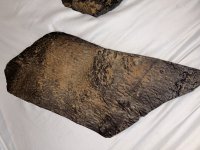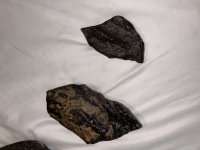These pieces were all found together in central WI. Very dense for their size. Not magnetic. Does NOT leave a streak on streak plate. Videos show better but unfortunately can’t post those on here. They sound metallic but they seem to be comprised of some sort of dark colored/black silica? The exterior looks vitrified. I’ve tried many places but no one seems to know what these could be. Open to all suggestions and if I should take these somewhere. Already tried a local university professor but they didn’t know either lol. Thanks in advance!
Find's Treasure Forums
Welcome to Find's Treasure Forums, Guests!
You are viewing this forums as a guest which limits you to read only status.
Only registered members may post stories, questions, classifieds, reply to other posts, contact other members using built in messaging and use many other features found on these forums.
Why not register and join us today? It's free! (We don't share your email addresses with anyone.) We keep email addresses of our users to protect them and others from bad people posting things they shouldn't.
Click here to register!
Need Support Help?
Cannot log in?, click here to have new password emailed to you
Need help identifying pls
- Thread starter KadeBlack
- Start date



